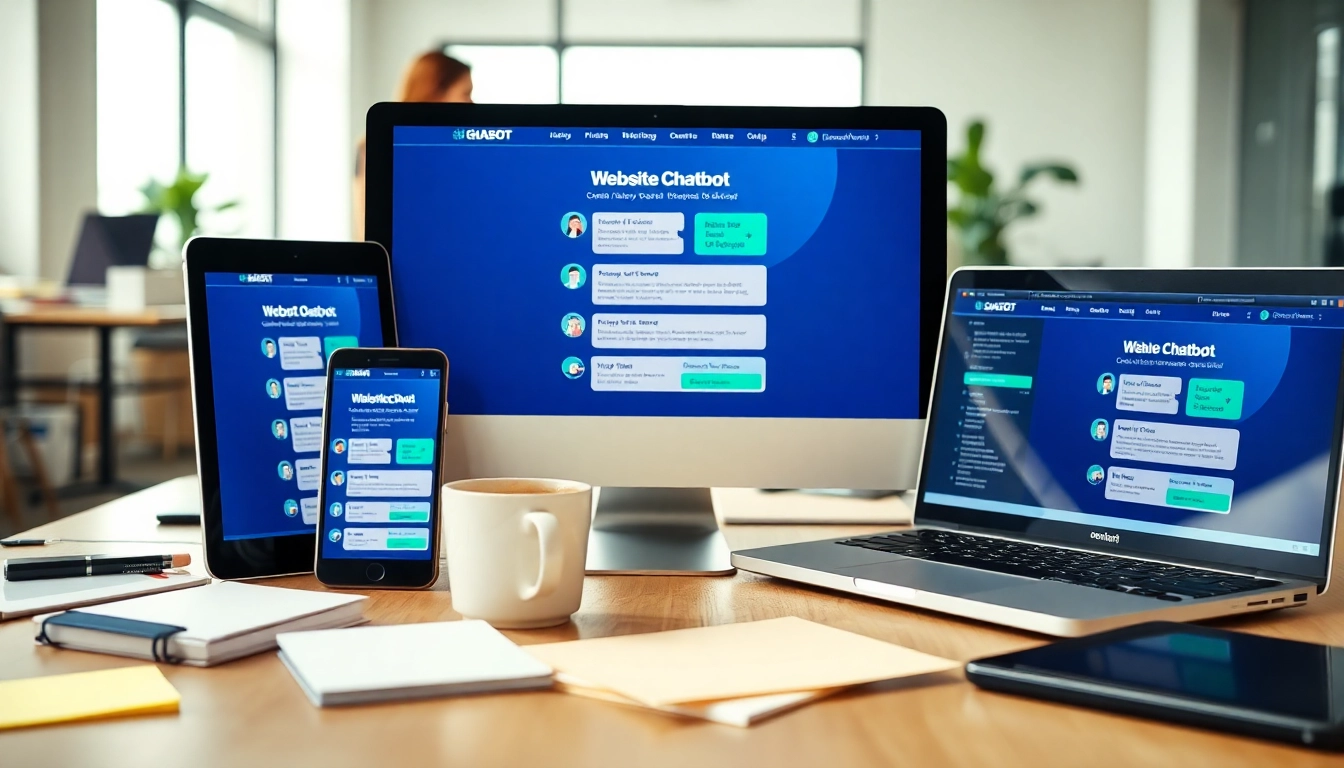Introduction to Website Chatbots
Website chatbots have emerged as an essential tool for businesses striving to enhance customer engagement and streamline operations. These digital assistants are designed to interact with human users in real-time, mimicking human conversation through text or voice interactions. As companies increasingly recognize the value of providing immediate assistance, the deployment of a website chatbot offers a way to meet customer needs efficiently. In this article, we will explore their definitions, benefits, common features, and trends that characterize this rapidly evolving technology.
What is a Website Chatbot?
A website chatbot is a software application that uses artificial intelligence (AI) and natural language processing (NLP) to simulate human conversation. It can answer questions, engage users in dialogue, and perform tasks based on a user’s request. These chatbots can exist in various forms, from simple automated responses to complex systems that learn and adapt over time based on user interactions.
Benefits of Using Website Chatbots
Implementing a chatbot on your website can yield numerous benefits:
- Improved Customer Support: Chatbots offer 24/7 assistance, allowing users to get help any time of day, which significantly enhances customer satisfaction.
- Cost Efficiency: Automating responses to frequently asked questions reduces the need for extensive human resources, leading to lower operational costs.
- Increased Engagement: Chatbots can proactively engage with visitors, offering help and recommendations that may lead to higher conversion rates.
- Data Collection: Chatbots can gather valuable insights regarding customer preferences and behaviors, which can inform marketing strategies.
Common Features of Effective Chatbots
When considering the implementation of a website chatbot, it’s crucial to understand the features that make them effective:
- Natural Language Understanding: The ability to comprehend and respond to user queries in a conversational manner.
- Multilingual Support: The capability to interact with users in various languages, catering to a broader audience.
- Integration with Other Tools: Compatibility with CRM systems, email services, and other platforms for seamless operations.
- Analytics and Tracking: Features that enable the monitoring of chatbot interactions for improving performance and effectiveness.
Implementing a Website Chatbot
The process of implementing a website chatbot involves essential steps from selection to customization. A strategic approach ensures you choose the right tools and create an optimal user experience.
Steps to Choose the Right Chatbot Platform
Choosing the right platform for your website chatbot is crucial. Here are some steps to consider:
- Define Your Goals: Understand what you aim to achieve with the chatbot (e.g., customer support, lead generation).
- Research Available Platforms: Evaluate different chatbot platforms based on user reviews, features, and pricing.
- Test for Usability: Most platforms provide trial periods; leverage this to test functionality and ease of use.
- Assess Integration Capabilities: Ensure the chatbot can seamlessly integrate with your existing tech stack.
Integrating Chatbots with Existing Systems
Integrating a chatbot into your existing systems is a critical step. Here’s how to do it effectively:
- API Availability: Check if the chatbot platform provides APIs for easy integration with your existing software.
- Collaboration with Developers: Work with your IT team to address integration priorities and address potential hiccups.
- Testing: Before going live, conduct rigorous tests to ensure that the chatbot works seamlessly with your existing systems.
Customizing Chatbot Interactions for User Experience
Customizing interactions is key to enhancing user experience:
- Personalization: Leverage user data to provide tailored responses and recommendations.
- Conversational Design: Craft dialogues that sound natural and engaging to the user, utilizing casual and friendly language.
- Feedback Mechanisms: Enable users to rate their experience, providing valuable insights into areas for improvement.
Optimizing Your Website Chatbot for Performance
Once your chatbot is live, ongoing optimization is key to ensuring performance remains high. This involves measuring engagement, testing scripts, and using analytics.
Measuring Engagement and User Satisfaction
Monitoring user engagement is vital for assessing the effectiveness of your chatbot. Key metrics to measure include:
- Response Times: Evaluate how quickly the chatbot responds to user inquiries.
- Completion Rates: Analyze how many users complete the desired actions after interacting with the chatbot.
- User Satisfaction Scores: Implement post-interaction surveys to gauge user satisfaction levels.
A/B Testing Chatbot Scripts for Improvement
A/B testing can be a powerful way to optimize chatbot scripts:
- Identify Variables: Choose variables to test, such as greetings or response styles.
- Run Tests: Deploy variations simultaneously and collect data on user interactions.
- Analyze Results: Determine which variations led to higher engagement or satisfaction rates.
Utilizing Analytics to Enhance Functionality
Analytics provide insights that help in enhancing chatbot functionality. Focus on:
- User Interaction Patterns: Analyze common queries and the flow of conversations to improve future interactions.
- Performance Benchmarks: Track key performance indicators (KPIs) over time to gauge chatbot effectiveness.
- Continual Adaptation: Use analytics to inform updates and improvements, adapting to changing user needs.
Troubleshooting Common Website Chatbot Issues
As with any technology, troubleshooting common issues can save time and enhance user experience. Here are frequent challenges and solutions:
Frequently Encountered Challenges
Common issues include:
- Misunderstanding User Queries: Users may receive incorrect responses if the chatbot doesn’t comprehend the queries accurately.
- Technical Failures: Downtime or bugs can happen, causing interruptions in service.
- Low Engagement Rates: If users find the chatbot unhelpful or difficult to interact with, they may disengage.
Best Practices for Resolving Technical Glitches
Addressing technical issues effectively requires a systematic approach:
- Regular Updates: Keep the chatbot software up-to-date to minimize bugs and enhance functionality.
- Monitoring Systems: Implement monitoring tools to quickly detect and address issues as they arise.
- User Support: Provide users with alternative ways to get help if the chatbot is down, such as FAQs or human support.
Improving User Feedback Mechanisms
Continuous improvement relies on user feedback. Implement these strategies:
- User Surveys: Regularly conduct surveys asking users about their experiences and suggestions for improvement.
- Engagement Metrics: Track user interactions and feedback over time to identify trends and patterns.
- Implement Feedback: Make adjustments to the chatbot based on user feedback and performance data.
Future Trends in Website Chatbot Technology
The realm of website chatbots is continually evolving, influenced by advancements in technology and changes in user expectations.
The Role of AI in Chatbot Evolution
Artificial intelligence is at the core of modern chatbot capabilities. The evolution of AI enables chatbots to:
- Learn from Interactions: AI-powered chatbots can improve responses based on user behavior and language.
- Predict User Needs: With machine learning, chatbots can anticipate user needs based on historical data and trends.
- Provide Contextual Responses: Advanced AI allows for more nuanced and contextually relevant interactions.
Predictions for Chatbot Usage in Businesses
As businesses recognize the value of chatbots, their usage is expected to soar. Some predictions include:
- Widespread Adoption: Businesses across industries will increasingly integrate chatbots into their operations to improve efficiency and customer engagement.
- Enhanced Customization: More companies will develop custom chatbots tailored to their specific industry needs, providing unique functionalities.
- Broader Applications: Beyond customer support, chatbots will see applications in areas like sales, onboarding, and education.
Staying Ahead of Competitive Landscape with Innovation
To remain competitive, businesses must continually innovate their chatbot offerings. This can be achieved through:
- Regular Feature Updates: Constantly introducing new features that better serve customer needs.
- Investing in R&D: Allocating resources to research emerging technologies that can enhance chatbot functionalities.
- Collaborative Development: Work with users and stakeholders to develop chatbots that address real-world problems and improve user experience.


